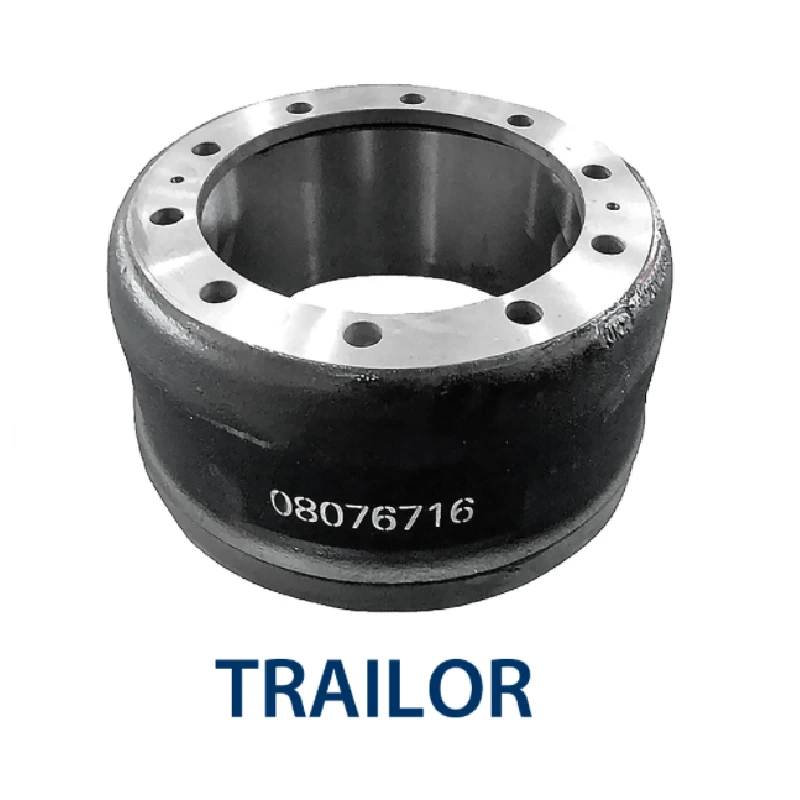Nov . 06, 2024 00:26 Back to list
Investigation into the Causes and Effects of Seized Brake Drums in Vehicles
Understanding Seized Brake Drums Causes, Consequences, and Solutions
In the realm of automotive maintenance, the brake system plays a critical role in ensuring the safety and efficiency of a vehicle. Among the various components that make up the braking system, the brake drum is often overlooked until problems arise. One significant issue that can occur with brake drums is seizing, which can lead to serious consequences if not addressed promptly. This article explores the causes of seized brake drums, the effects on vehicle performance, and possible solutions.
What is a Brake Drum?
A brake drum is a cylindrical part of the drum brake system, which slows the vehicle by causing friction against brake shoes. When the driver presses the brake pedal, hydraulic fluid transfers force from the pedal to the brake shoes, which then expand against the inside of the drum, generating the necessary friction to slow or stop the vehicle. While this system is effective, it can also be susceptible to various issues, particularly seizing.
Causes of Seized Brake Drums
1. Rust and Corrosion One of the most common causes of seized brake drums is rust accumulation. Brake drums, being exposed to moisture and road debris, can develop rust over time. When the rust builds up, it can lead to the adhesion of the brake shoes to the drum, making it difficult for the brakes to release.
2. Lack of Maintenance Regular maintenance is crucial for any vehicle, and failing to inspect and service the brake system can lead to various problems, including seized brake drums. Neglecting to replace worn-out brake shoes or not adjusting them properly can exacerbate the seizing issue.
3. Overheating Prolonged or excessive use of the brakes can result in overheating, which can warp the brake drum. Warped drums may not provide a proper fit for the brake shoes and can cause them to stick, leading to seizing.
4. Moisture and Contaminants Water, dirt, and other contaminants can invade the brake drum area, contributing to seizing. Moisture can cause the brake shoes to swell, increasing the likelihood of them sticking to the drum.
Consequences of Seized Brake Drums
seized brake drum

The consequences of having seized brake drums can be severe. Firstly, it can lead to decreased braking efficiency, resulting in longer stopping distances and potentially increasing the risk of accidents. Drivers may notice that the brakes feel sluggish or unresponsive. Additionally, a seized brake drum can cause uneven wear on the braking components, leading to further damage and requiring costly repairs.
Moreover, the stress from the sticking brake shoes can generate excessive heat, which can damage other parts of the braking system, including the brake lines, wheel bearings, and even the transmission. Ignoring the signs of a seized brake drum can ultimately put both the driver and others on the road in danger.
Solutions and Preventive Measures
Addressing seized brake drums involves a combination of inspection, maintenance, and sometimes repair or replacement of the affected parts. Here are several steps to mitigate the issue
1. Regular Inspections Schedule routine inspections of your braking system to catch issues before they escalate. Checking for rust, worn-out brake shoes, and other signs of wear can prevent seizing.
2. Cleaning and Lubrication Keeping the brake components clean and properly lubricated can help reduce friction and prevent seizing. Brake cleaner can remove contaminants, and anti-seize compound can be applied to areas where the brake shoes meet the drum.
3. Timely Repairs and Replacements If you notice signs of seizing, such as unusual noises or decreased braking performance, seek professional help immediately. Replacing rusted or warped drums and worn brake shoes can restore the system's functionality.
4. Driving Habits Being mindful of driving habits can also play a role in preventing seized brake drums. Avoiding excessive braking and practicing smooth stops can reduce strain on the braking system.
In conclusion, understanding the implications of seized brake drums can arm vehicle owners with the knowledge necessary to maintain their cars effectively. Recognizing the signs early and taking preventive measures can ensure a safe driving experience and enhance the longevity of the vehicle's braking system.
-
Durable Brake Drum MAZ for Heavy Duty Trucks | High Performance
NewsAug.26,2025
-
FUWA: Premium Quality, Reliable Performance & Innovative Solutions
NewsAug.25,2025
-
Liza Brake Drum: Superior Quality & Performance for Safe Driving
NewsAug.24,2025
-
Iveco Brake Drum | Premium OE Quality for Daily & Eurocargo
NewsAug.22,2025
-
Your Brake Drum Man: Quality & Performance Parts
NewsAug.21,2025
-
Explore Japan: Ultimate Travel Guide & Authentic Experiences
NewsAug.19,2025
